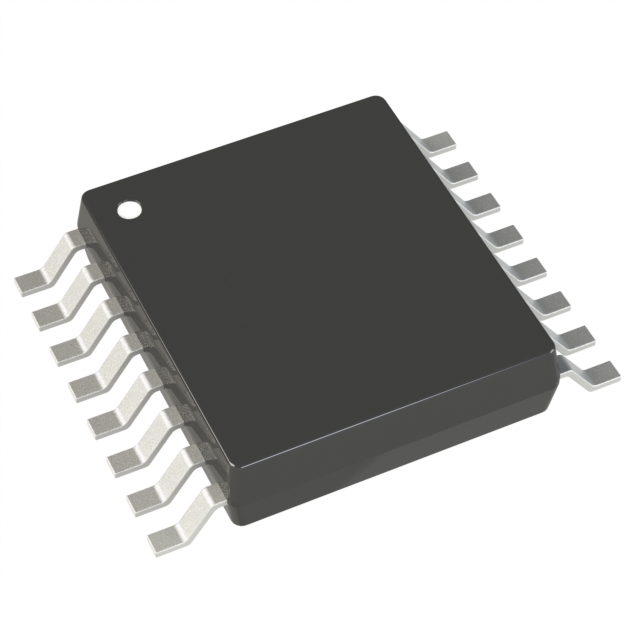AD7924BRUZ
Product Overview
Category: Analog-to-Digital Converter (ADC)
Use: The AD7924BRUZ is a high-performance, 12-bit successive approximation register (SAR) ADC. It is designed for precision measurement applications that require accurate conversion of analog signals into digital data.
Characteristics: - Resolution: 12 bits - Sampling Rate: Up to 1 MSPS (Mega Samples Per Second) - Input Voltage Range: ±VREF - Low Power Consumption: 2.5 mW at 1 MSPS - Operating Temperature Range: -40°C to +85°C
Package: The AD7924BRUZ comes in a small 16-lead TSSOP (Thin Shrink Small Outline Package) which provides good thermal performance and ease of handling during assembly.
Essence: This ADC offers high accuracy and low power consumption, making it suitable for a wide range of precision measurement applications.
Packaging/Quantity: The AD7924BRUZ is available in tape and reel packaging, with 2500 units per reel.
Specifications
- Resolution: 12 bits
- Number of Channels: 4
- Input Voltage Range: ±VREF
- Conversion Time: 1 µs (typical)
- Supply Voltage: 2.7 V to 5.25 V
- Power Consumption: 2.5 mW at 1 MSPS
- Operating Temperature Range: -40°C to +85°C
- Interface: SPI (Serial Peripheral Interface)
Pin Configuration
The AD7924BRUZ has a total of 16 pins. Here is the detailed pin configuration:
| Pin Number | Pin Name | Description | |------------|----------|-------------| | 1 | VDD | Power Supply Voltage | | 2 | VREF | Reference Voltage Input | | 3 | AGND | Analog Ground | | 4 | VIN1 | Analog Input Channel 1 | | 5 | VIN2 | Analog Input Channel 2 | | 6 | VIN3 | Analog Input Channel 3 | | 7 | VIN4 | Analog Input Channel 4 | | 8 | DGND | Digital Ground | | 9 | SCLK | Serial Clock Input | | 10 | SDI | Serial Data Input | | 11 | CS | Chip Select Input | | 12 | SDOUT | Serial Data Output | | 13 | RDY | Ready Indicator Output | | 14 | CONVST | Conversion Start Input | | 15 | RESET | Reset Input | | 16 | VIO | Digital Supply Voltage |
Functional Features
- High-resolution ADC with 12-bit accuracy
- Four input channels for simultaneous conversion
- Low power consumption for energy-efficient operation
- Fast conversion time of 1 µs (typical)
- Wide operating temperature range for versatile applications
- SPI interface for easy integration with microcontrollers and digital systems
Advantages and Disadvantages
Advantages: - High accuracy and resolution - Low power consumption - Simultaneous conversion of multiple channels - Wide operating temperature range - Easy integration with digital systems
Disadvantages: - Limited number of input channels (only four) - Requires an external reference voltage (VREF)
Working Principles
The AD7924BRUZ is based on the successive approximation register (SAR) architecture. It uses a capacitive digital-to-analog converter (DAC) to compare the input analog voltage with a binary-weighted reference voltage. The SAR algorithm iteratively approximates the input voltage by adjusting the DAC's output until it matches the input voltage within the desired accuracy.
Detailed Application Field Plans
The AD7924BRUZ is suitable for various applications that require high-precision analog-to-digital conversion. Some potential application fields include:
- Industrial Automation: Measurement and control systems, process monitoring, and data acquisition.
- Medical Instruments: Patient monitoring devices, diagnostic equipment, and laboratory instruments.
- Test and Measurement: Oscilloscopes, data loggers, signal analyzers, and spectrum analyzers.
- Communication Systems: Base stations, wireless infrastructure, and satellite communication equipment.
- Automotive Electronics: Engine control units, battery management systems, and sensor interfaces.
Detailed and Complete Alternative Models
- AD7091R-12: 12-bit SAR ADC with single-channel input and SPI interface.
- AD7685: 16-bit SAR ADC with eight input channels and low power consumption.
- ADS8860: 18-bit SAR ADC with four input channels and high accuracy.
- LTC1867: 16-bit SAR ADC with
Lista 10 Vanliga frågor och svar relaterade till tillämpningen av AD7924BRUZ i tekniska lösningar
Sure! Here are 10 common questions and answers related to the application of AD7924BRUZ in technical solutions:
Q: What is AD7924BRUZ? A: AD7924BRUZ is a 12-bit, 4-channel analog-to-digital converter (ADC) that can be used to convert analog signals into digital data.
Q: What is the operating voltage range of AD7924BRUZ? A: The operating voltage range of AD7924BRUZ is typically between 2.7V and 5.5V.
Q: How many channels does AD7924BRUZ have? A: AD7924BRUZ has 4 input channels, allowing you to measure up to 4 different analog signals simultaneously.
Q: What is the resolution of AD7924BRUZ? A: AD7924BRUZ has a resolution of 12 bits, which means it can represent analog signals with 4096 discrete levels.
Q: What is the maximum sampling rate of AD7924BRUZ? A: AD7924BRUZ has a maximum sampling rate of 1 MSPS (Mega Samples Per Second), allowing for fast and accurate conversions.
Q: Does AD7924BRUZ have an internal reference voltage? A: Yes, AD7924BRUZ has an internal reference voltage of 2.5V, which can be used as a reference for the ADC conversions.
Q: Can I use AD7924BRUZ in low-power applications? A: Yes, AD7924BRUZ has a low-power mode that allows you to reduce power consumption when not actively converting analog signals.
Q: What is the interface of AD7924BRUZ? A: AD7924BRUZ uses a serial interface (SPI) for communication with microcontrollers or other digital devices.
Q: Can I use AD7924BRUZ in industrial applications? A: Yes, AD7924BRUZ is designed to operate in industrial temperature ranges (-40°C to +85°C) and can be used in various industrial applications.
Q: Are there any evaluation boards or development kits available for AD7924BRUZ? A: Yes, Analog Devices provides evaluation boards and software tools that can help you quickly prototype and evaluate the performance of AD7924BRUZ in your application.
Please note that these answers are general and may vary depending on specific requirements and use cases. It's always recommended to refer to the datasheet and consult with the manufacturer for detailed information.


